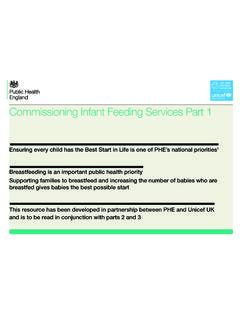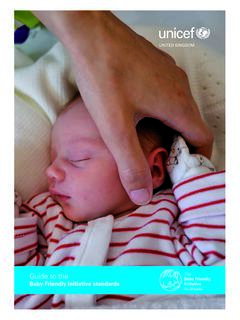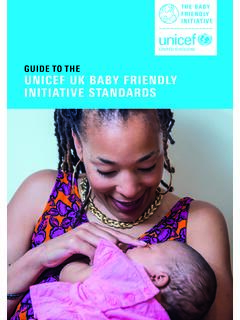Transcription of Early Intervention for Children and Families
1 Grasping the nettle: Early Intervention for Children , Families and communities A practice guide to the challenges and opportunities in supporting Children , Families and communities through Early Intervention , based on effective local, national and international practice. 2 Contents Foreword 3 Executive Summary 4 1. The policy context 14 2. Five golden threads a summary 17 3. The best start in life 19 4. Language for life 31 5. Engaging parents 40 6. Smarter working, better services 51 7.
2 Knowledge is power 64 8. Where is it best to invest? 74 Appendix I Membership of Expert Group 80 References 81 3 Foreword Early Intervention is a force for transforming the lives of Children , Families and communities, particularly the most disadvantaged. Its importance today in terms of policy and practice owes as much to its economic sense, as well as the social and personal benefits that it can generate. Since our joint call for evidence of effective local practice in Early Intervention at the beginning of the year, we have been overwhelmed by the response; over 100 submissions have already been received and more are coming in by the day.
3 In parallel, we commissioned a rapid review of international experience to build a solid base of evidence. By teasing out and distilling the key messages from this wealth of evidence of what works , including research findings, this practice guide aims to support local authorities and their partners in improving the quality of life for the Children , Families and communities that they serve. Ultimately, tough decisions need to be taken at a national and local level in the best interests of Children , Families , communities and the long-term prosperity of the country. Not only does this guide identify specific interventions proven to work, but, in a number of examples, it also includes information on the costs of effective interventions at project level.
4 This knowledge should assist both national and local policy-makers in helping decide where to allocate scarce resources and thereby achieving better value for money, especially during times of austerity. Whilst celebrating the considerable progress made by local areas in recent years and highlighting innovations that have been developed at home and abroad, this guide guards against complacency by focussing on a number of key areas for development. In order to sustain improvements, it is vital that these areas are acted on with urgency. Our thanks go to Simon Bird and Martin Rogers for pulling the evidence together for this report, with guidance from June Statham (Institute of Education); to George Hosking and Ita Walsh of the Wave Trust for producing the evidence of effective international practice; and, most of all, to those who submitted examples of local practice considered by C4EO s validation process.
5 C4EO s Expert Group has also provided invaluable advice throughout. We share the Coalition G overnment s belief that strong and stable Families of all kinds are the bedrock of a strong and stable society , and very much welcome its decision to set up an independent commission on Early Intervention chaired by Graham Allen, MP for Nottingham North. We hope that this practice guide will support the important work of the commission. Christine Davies CBE Kim Bromley-Derry C4EO Director Chair, C4EO Early Intervention Expert Group (Immediate Past President, ADCS) 4 Executive Summary Background The growing interest in Early Intervention as a policy issue reflects the widespread recognition that it is better to identify problems Early and intervene effectively to prevent their escalation than to respond only when the difficulty has become so acute as to demand action.
6 It is better for the individuals concerned, their Families and society more broadly; it avoids a lot of personal suffering, reduces social problems and generally, it costs less than remedial action so Early Intervention is nothing new. What has changed is that our knowledge and understanding of human development, especially in childhood, has grown to the point that we can now identify many more problems earlier; some we can even anticipate, or clearly predict a risk factor. Practice has also developed to enable us to intervene more effectively to address many of these problems. Such developments are continual, but we appear to have reached a tipping point where our knowledge and practice have progressed sufficiently to make the policy question not whether we should invest in Early Intervention , but how can we not do so?
7 To reflect its strategic importance, Early Intervention became the latest cross-cutting theme in the Centre for Excellence and Outcomes (C4EO s) programme of work, with a joint call for evidence with ADCS (Association of Directors of Children s Services) to help build the knowledge base and support local areas in learning from each other about effective approaches. Over 100 submissions have been received (with more coming in), which have been subject to C4EO s validation process to assess their impact and their potential for replication in different contexts in other local areas. About a quarter of the submissions met C4EO s criteria for effective practice, and most of these are summarised in this publication.
8 C4EO, through its Expert Group on Early Intervention , also commissioned the Wave Trust to undertake a rapid review of international experience of Early Intervention . As with the local practice examples, evidence of effective practice from abroad has been distilled into case studies for inclusion in this publication. Running alongside both of these main sources of evidence are key findings and messages from academic research. Main findings The most striking message is that Early Intervention clearly works when it is an appropriate Intervention , applied well, following timely identification of a problem; and the earlier the better to secure maximum impact and greatest long term sustainability (both as Early in the child s life as possible and/or as soon as possible after a difficulty becomes apparent).
9 The wealth of effective local, national and international practice showing evidence of improvements in outcomes and the quality of life for many Children and Families gives cause Definition of Early Intervention For the purposes of this practice guide, the following definition is used: i ntervening Early and as soon as possible to tackle problems emerging for Children , young people and their Families or with a population most at risk of developing problems. Early Intervention may occur at any point in a child or young person s life . 5 for optimism, and encouragement to replicate local innovations more widely. Indeed, some of the examples describe practice that has already spread widely (often internationally) from its local origins.
10 A clear need has been identified for more research into the effectiveness and the relative cost-effectiveness of Early Intervention strategies, but several characteristics emerge as common to a number of the successful examples described. These are reflected in five golden threads , which are described in chapter 2, and form the headings for the thematic chapters that follow. Where possible, these golden threads need to be taken together, when they constitute a coherent strategy for systemic change. Five golden threads The best start in life Language for life Engaging parents Smarter working, better services Knowledge is power.





